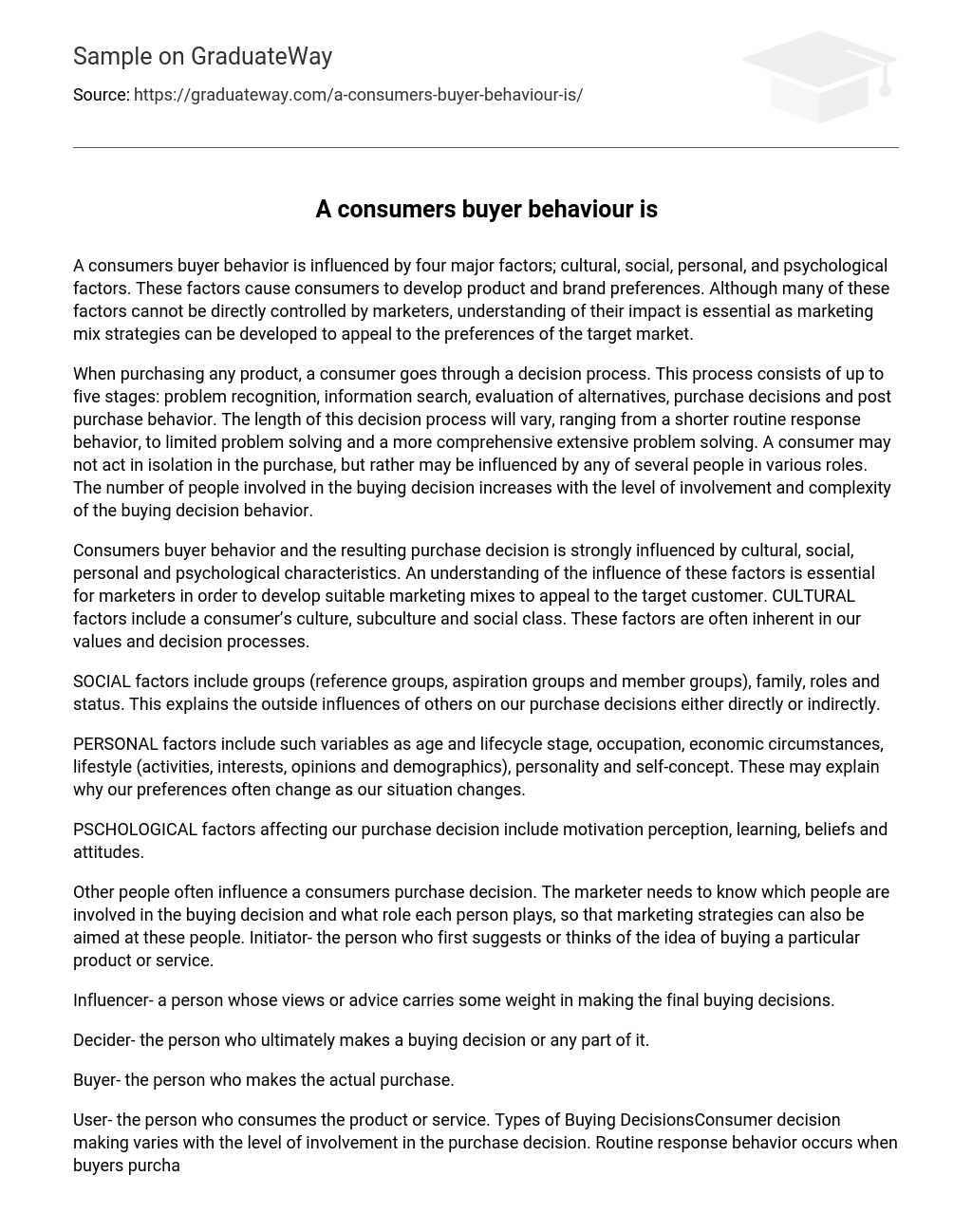Four major factors influence a consumer’s buyer behavior: cultural, social, personal, and psychological factors. These factors contribute to the development of product and brand preferences. While marketers cannot directly control many of these factors, it is crucial to understand their impact in order to create marketing strategies that cater to the preferences of the target market.
Consumers follow a five-stage decision process when purchasing a product: problem recognition, information search, evaluation of alternatives, purchase decisions, and post purchase behavior. The length of this process can vary from a shorter routine response behavior to limited problem solving or more extensive comprehensive problem solving. The purchase decision may not be made by the consumer alone but can be influenced by various individuals in different roles. The number of people involved in the buying decision increases with the level of involvement and complexity of the buying decision behavior.
Understanding the impact of cultural, social, personal, and psychological characteristics is essential for marketers to effectively appeal to consumers. Factors such as culture, subculture, and social class greatly influence purchasing decisions and shape our values.
Social factors encompass various aspects, such as reference groups, aspiration groups, member groups, family, roles, and status. These factors elucidate how external influences from others impact our purchasing choices, whether directly or indirectly.
The PERSONAL factors that impact our preferences consist of age, lifecycle stage, occupation, economic circumstances, lifestyle (including activities, interests, opinions, and demographics), personality, and self-concept. These factors can elucidate the reason behind the fluctuation in our preferences as our situation evolves.
There are various psychological factors that influence our decision to buy, such as motivation, perception, learning, beliefs, and attitudes.
Marketers must recognize and understand the individuals involved in a purchasing decision, as well as the significant influence others have on consumers’ buying choices. By gaining insight into these individuals, marketers can improve their strategies. In particular, the initiator is the person who first proposes or considers buying a particular product or service.
An influencer is someone who greatly influences the final purchasing decisions through their opinions or recommendations.
The person who holds the ultimate authority to make a decision about a purchase or has influence over it is often called the “decider”.
The person responsible for making the actual purchase is referred to as the “buyer”.
The term “user” pertains to the person utilizing the product or service. Consumer decision-making differs based on their level of involvement in the purchase decision. Routine response behavior is noticeable when purchasers obtain inexpensive items that they are acquainted with and frequently purchase. Limited problem solving arises when buyers come across an unfamiliar brand within a familiar product category. Conversely, extensive problem solving emerges when buyers acquire expensive products that are not usually purchased within an unfamiliar product category.
The Consumer Expenditure Survey gathers data on the purchasing behaviors, income, and characteristics of households and families in the country. Its benefit lies in enabling users to connect consumer expenditures and income with consumer characteristics. The survey is divided into two parts: a quarterly Interview Survey and a weekly Diary Survey, both having separate questionnaires and samples.
The Consumer Expenditure Survey serves a range of users with different objectives. Market researchers utilize the data to comprehend demand for groups of goods and services, enabling them to track spending patterns across diverse consumer types. Government and private agencies depend on the data to assess the well-being of specific population segments, such as consumer units comprised of individuals aged 65 and older or under 25, as well as low-income consumer units. Economic policymakers analyze the data to evaluate how policy changes impact various socioeconomic groups. Researchers employ the data for numerous studies, including those investigating spending behavior among different family types, trends in expenditures for various components (including new goods and services), gift-giving behavior, consumption patterns, and historical spending trends. The Bureau of Labor Statistics (BLS) extensively utilizes the survey to periodically revise the Consumer Price Index (CPI). The survey results aid in selecting new market baskets consisting of goods and services for CPI calculation purposes, determining relative importance within CPI components, and establishing new cost weights for these market baskets.





